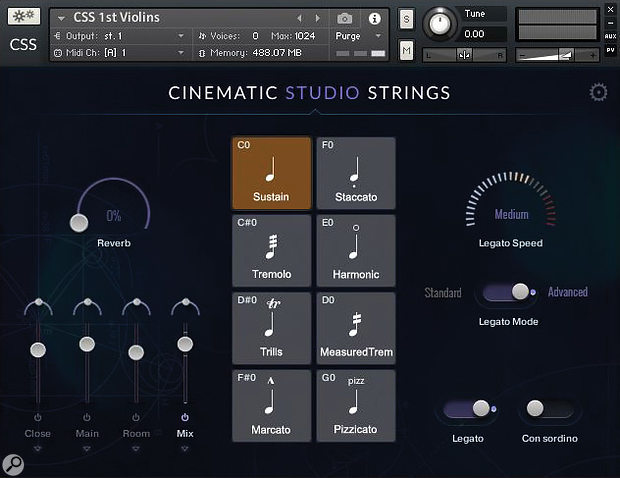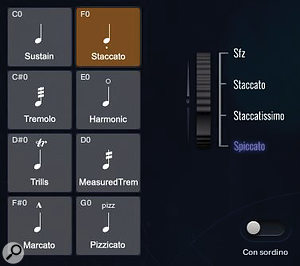It’s time for Intro to Orchestral Sample Libraries, Part III: String Articulations. When I first started learning about Orchestral Sample Libraries, I kept hearing about these things called “articulations” and, while I had a general idea of what they were, I found myself always stumbling over the meaning of each; this often made it difficult for me to know the best way to use them. While I did study classical music theory in school, I was mostly a percussion, guitar and piano player and I have never played any of the other instruments of the orchestra (violin, cello, etc). Initially had a difficult time appreciating the importance of the various articulations and the unique sounds that these instruments can produce. Understanding how to use articulations is one of the most important aspects of producing orchestral music. If you’re not a trained string player, you’ll want to spend time studying each articulation and knowing how and when to use them as this will make your final compositions more dynamic as well as sound more realistic as you’ll be “playing” the instruments closer to how a real instrumentalist would play it. Only in rare cases would a player use a single articulation for an entire piece of music!
To complicate this topic further, it seems like each creator of orchestral sample libraries includes different articulations and can use different names for them. So, for this lesson, I’m going to try to cover the main articulations that I see shared across most libraries. You might find libraries that include some of these, as well as additional ones. As with the other lessons in this Intro series, Wet vs Dry, and Ensembles vs Sections, this lesson is for people who are new to using orchestral sample libraries, and is focused on the String family of the orchestra; however, these concepts apply to other instrument families as well.
To start, lets first look at what I’m talking about by viewing the string articulations offered by Cinematic Studio Strings (see photo below.) Note the names of each articulation choices: Sustain, Staccato, Tremolo, Harmonica, etc. When you select an articulation, you are loading up a new set of samples that are recorded for that selected articulation.

Before we dive into the description and sound of each articulation, at a high level, I think it helps first to understand that most articulations fall into just a couple categories: Long and Short being the two main ones to be familiar with. There could be a separate category of Effects and/or Decorative styles, which, might also be “long” or “short” in duration, but, for the purpose of producing orchestral music in this context, these “special” articulations are often used more for effects and to add color, texture and more realism to the sound. So, I will identify these articulations separately here.
Long String Articulations
Long strings, like the name implies, is when the note is held (longer) – this is usually referred to a sustained note. Within this Long category, you might find variations of Long articulations, and/or see different names used such as “arco,” “legato,” “portamento,” “tremolo.” Regardless of the term used, and I will go into more detail about the sound of each below, the main point I’m making is that a Long string articulation means that the note is held verses stopping the sustain from ringing out as in a “short”.
Common Long String Articulations
Sustain
This is probably the most common, well-understood articulation as it is easy to imagine the string section playing a single note with their bows and then holding it (sustain). You might also see this called “Arco” or “Arco Strings” – which means, “play with bow.”
Good for: All purpose, multi-genre. Creating melodies with longer notes that need to be held for a period of time, verses many notes played rapidly together.
Legato
What makes Legato special, is that it captures the transition between two sustain notes. Imagine a string player starting on an “A” note and then moving to a “C” note with a single bow. Legato has the effect of creating a softer attack of the transition note(s) – often referred to as a “blurring” – verses two totally separate notes played one after the other. In the context of a sample library, the library creators will actually record every possible transition between two notes, and then use the programming language of the sample software to control how the notes and transitions are triggered. This is all in order to make the transitions between notes sound more realistic. Yes, this is A LOT of work for the people making the sample library, and it has become expected for any modern sample library that wants to be competitive in the marketplace. Still, not all libraries include legato, so if this is important to you, make sure you check before you buy!
Good for: All purpose, multi-genre. Creating melodies with longer notes that need to be held for a period of time, verses many notes played rapidly together and for creating realistic transitions between notes.
Tremolo
Very useful for creating suspense in music, the Tremolo articulation creates a vibrating, “tremble” effect by rapidly playing a note. Imagine a string player moving their bow back and forth very quickly (in very small movements). Instead of the smooth, flowing sound that comes from a sustained note, the sound that is produced from a tremolo articulation, sounds very active and “nervous” as the sound “trembles” back and forth. While some could argue that tremolo is a bit of an effect, and might be called decorative, I find that tremolo articulations are usually included as “long” (sustained) notes, and, within the context of a score, often get used in a similar way as a sustain articulation would.
Good for: Creating suspense, tension, and adding texture and color. Common in horror music! Usually better for longer notes held over a period of time, vs shorter repetitions.
Vibrato
Similar to the tremolo, and often confused with tremolo, vibrato is a rapid variation in pitch of a note. This variation could be both above and below the note (a little higher and a little lower).
Good for: Creating suspense, tension, and adding texture and color. Usually better for longer notes held over a period of time, vs shorter repetitions.
Portamento
A glide from one note to the next. Imagine the player sliding into a note – it almost gives that “tuning in” to a note sound when tuning the instrument! Portamento is often used interchangeably with Glissando (see below), although, Glissando is usually more used as an effect (decorative.)
Good for: All purpose, multi-genre. Adds more realism to transitions as it recreates the natural “slide” into notes that many players do.
Con Sordino (not necessarily “long,” can be used on “short” articulations as well)
Muted playing that can create a softened, more “darker” sound.
Good for: All purpose, multi-genre. Creating a soft, darker, muted sound. Sometimes strings can get too loud, harsh or distracting when many are played together – particularly in the higher registers. Playing some of the higher notes as Con Sordino, can reduce the “harsh” sound, as well as help other instruments poke through the score.
Short String Articulations
Having talked about Long strings above, can you guess what Short would be? Did you guess: Short notes? That is correct! We have to remember that instruments are capable of playing a wide range of sounds: long and sustained, as well as short and quick. A Short articulation is when the note does not sustain out – it is a short, often “bite” of a sound. I use the term “bite” because that is often what I think of when using Short articulations. Because the notes are not ringing out longer (eg not sustaining) they tend to have a tighter sound with more attack that is used for faster lines where lots of notes need to repeat quickly. Short articulations are interesting in that they often have a percussive feel that can even overshadow the tonal aspects in some instances.
Common Short String Articulations
Staccato
This is what I think of when someone says “short” notes. Sometimes, I’ve heard people describe any short note as “staccato.”
Good for: All purpose, multi-genre. Often used in faster music (eg Action) and when creating melodies with shorted that need to be played rapidly together.
Staccatissimo
Like Staccato, but even shorter!
Good for: All purpose, multi-genre. Often used in faster music (eg Action) and when creating melodies with shorted that need to be played rapidly together.
Spiccato
Short notes, like staccato, but with the bow bouncing off the string to create an even tighter, more percussive sound. I prefer Spiccato over Staccato for faster, more action-based compositions where I want the notes to cut through.
Good for: All purpose, multi-genre. Often used in faster music (eg Action) and when creating melodies with shorted that need to be played rapidly together.
Marcato
Strongly accented note with sharper attack (more emphasis.)
Good for: All purpose, multi-genre. Good for emphasizing certain notes in the melody and for melodies with shorted that need to be played rapidly together.

Effect Articulations (some of these could fall under “long” or “short” as well)
I’m not sure if effect is an official musical term, but this is how I describe articulations that, might fit in the “long” or “short” category, but, their main purpose is to add color, and more realism to the sound.
Common Effect Articulations
Pizzicato
Plucking of the strings, creating a light, bouncy sound with no sustain and little body (short, and more percussive.)
Good for: All purpose, multi-genre. This sounds is heard all over the Dramedy (Drama+Comedy) genre, where the goal is to create a fun, light sound that implies mischief along with a sense of humor.
Barktok Pizzicato
Plucking the strings hard enough to create a sharp, percussive effect (more percussive than tonal.)
Good for: short notes. acting as a member of the percussion family! Can sound very “hard” and big when played at high velocities and often mistaken for drums.
Col Legno
Striking the strings to create a sharp, percussive effect (more percussive than tonal.)
Good for: short notes. Making short notes sound percussive. Can be played in a way where it sounds like two instruments: one playing the tonal melody, the other playing the percussion.
Harmonic
Just the overtone of the note (not the sound of the fundamental.) The overtone is much thinner and higher in pitch, so it gives a very light almost ghostly sound.
Good for: layering over the main melody (sustain) as the higher overtones add additional color and richness to the sound without “doubling/thickening” the main melody notes.
Sul Tasto (aka Flautando)
Flautando means “like a flute” – which is what Sul Tasto can sound like. Playing the strings over the finger board to create a softer, lighter sound.
Good for: Similar to harmonic to layer on top of sustain notes and give more character, richness to the sound.
Watch the Youtube Video of this lesson!